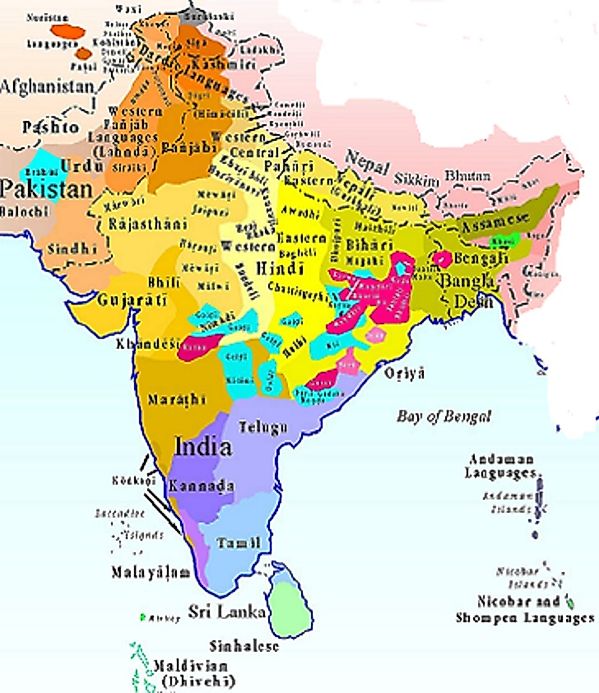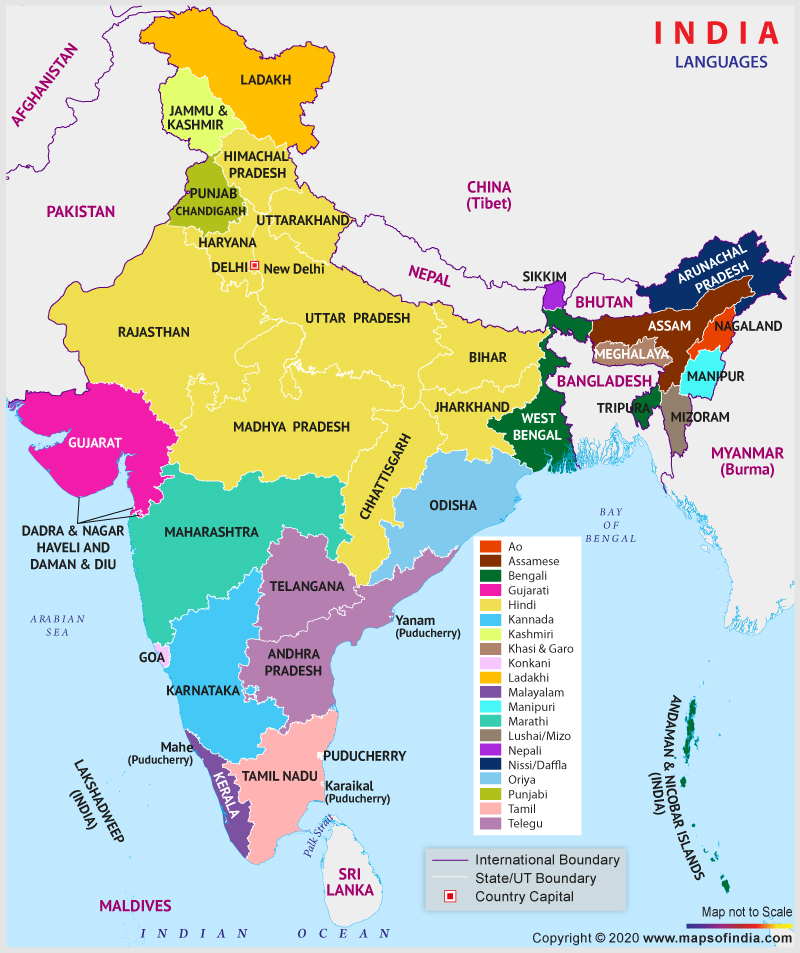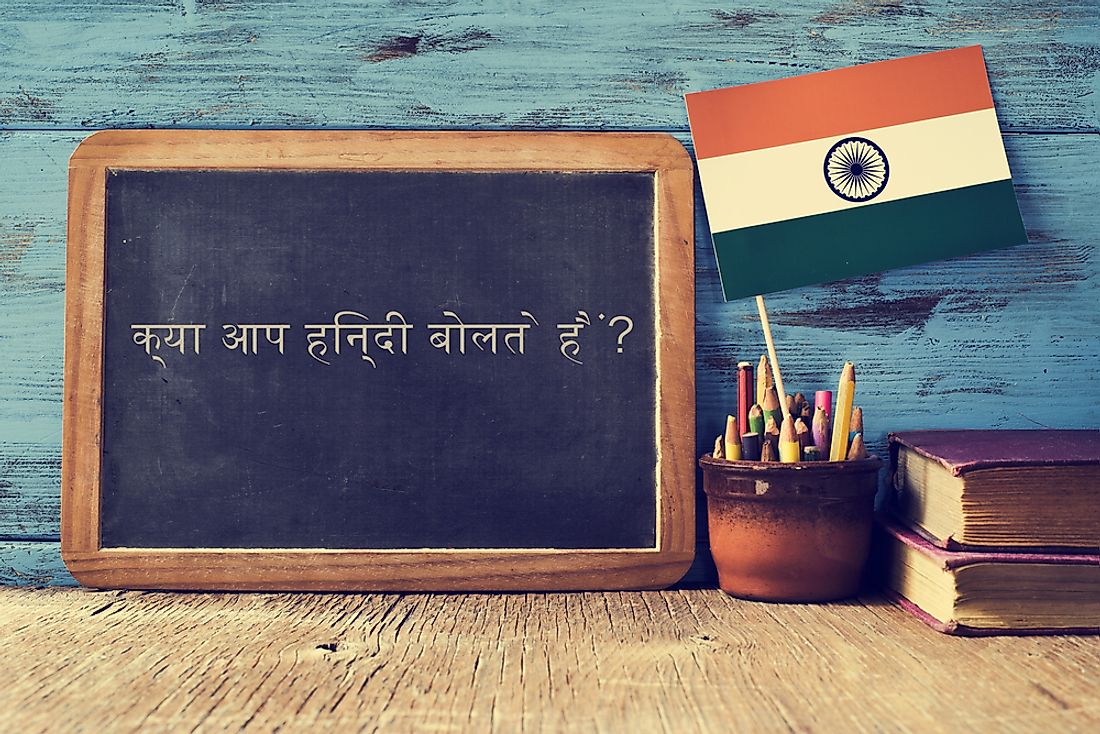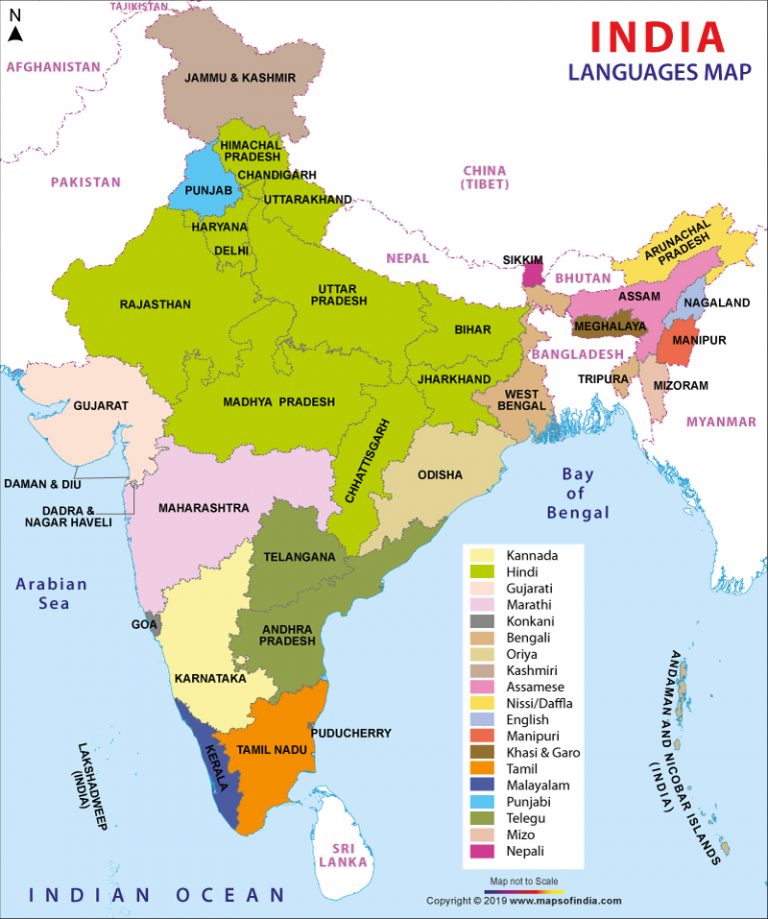As a proverb goes, "Every two miles the water changes, every four miles the speech." As per the 1961 Census, India had more than 1652 mother tongues, genetically belonging to five different language families. The 1991 Census had 10,400 raw returns of mother tongues and they were rationalized into 1576 mother tongues. After further rationalizing in the Census 2001, there is a total of 122 languages and 234 mother tongues in the country. However, there are 22 scheduled languages as per the eighth schedule of the Constitution of India. These languages are Assamese, Bengali, Gujarati, Hindi, Kannada, Kashmiri, Konkani, Malayalam, Manipuri, Marathi, Nepali, Oriya, Punjabi, Sanskrit, Sindhi, Tamil, Telugu, Urdu Bodo, Santhali, Maithili and Dogri.
During India's struggle for Independence, though every language played a role against colonial power, but, the question and need for a national language rose. A country, full of diverse languages and dialects, required a language to unify the people and the nation as a whole. Which language could perform this mammoth task of uniting people and nation building?
And the answer came from none other than the father of the nation, Mahatma Gandhi himself who had stressed the need of a national language. In his address to the Gujarat Education Conference at Bharuch in 1917, Gandhiji said that Hindi was the only language which could be adopted as national language because this is a language spoken by majority of the Indians. It had the potential of being used as an economic, religious and political communication link. The listing of Hindi as official language took place on September 14, 1949.
National Hindi Day or Hindi Diwas is, thus, celebrated every year to mark the day. Today, over 40 crore Indians regard Hindi as their mother tongue. As per census 2001, the share of Hindi speakers in the total population is 41%. Hindi is also the state language of the state of Bihar, Haryana, Himachal Pradesh, Madhya Pradesh, Uttar Pradesh and Rajasthan.
Besides, Indian Diaspora settled abroad and others in countries like USA, Mauritius, South Africa, Yemen, New Zealand and Nepal, etc., across the globe also speak Hindi, making it the world's third most spoken language. Hindi and Urdu are generally considered to be one spoken language with two different literary traditions. That means that Hindi and Urdu speakers who shop in the same markets have no problems understanding each other -- they'd both say yeh kitne kaa hay for 'How much is it? And the Urdu one will be یہ کتنے کا ہے؟ Hindi is written from left to right in the Devanagari script, and is the official language of India, along with English.
Urdu, on the other hand, is written from right to left in the Nastaliq script and is the national language of Pakistan. It's also one of the official languages of the Indian states of Bihar and Jammu & Kashmir. Considered as one, these tongues constitute the second most spoken language in the world, sometimes called Hindustani. In their daily lives, Hindi and Urdu speakers communicate in their 'different' languages without major problems.
Both Hindi and Urdu developed from Classical Sanskrit, which appeared in the Indus Valley at about the start of the Common Era. The first old Hindi poetry was written in the year 769 AD, and by the European Middle Ages it became known as 'Hindvi'. Muslim Turks invaded the Punjab in 1027 and took control of Delhi in 1193. They paved the way for the Islamic Mughal Empire, which ruled northern India from the 16th century until it was defeated by the British Raj in the mid-19th century. It was at this time that the language of this book began to take form, a mixture of Hindvi grammar with Arabic, Persian and Turkish vocabulary. The Muslim speakers of Hindvi began to write in the Arabic script, creating Urdu, while the Hindu population incorporated the new words but continued to write in Devanagari script.
The major difference is that of script where urdu is written in persio-arabic script while hindi in devnagari. Both were almost similar languages in oral form 250 years back but now are different from each other due to persianization of urdu n sanskritization of hindi. Also hindi is the mother tongue of less than 50% of indians. There are hundreds of millions of tamil,telugu,bengali,punjabi,marathi,etc etc whose languages r entirely different from hindi. AssameseA language of Assam that's spoken by nearly 60 percent of the State's population.BengaliAn official language of West Bengal, now spoken by nearly 200 million people in West Bengal and in Bangladesh. BodoIt is the language spoken by the Bodo people of Assam and comes under the Assam-Burmese group of languagesDogriMainly spoken by the people of Jammu regionGujaratiIt is the official language of Gujarat.
70 percent of the State's population speak Gujrathi but it the most spread language not only in India but also abroad. HindiThe official language of India, accent and dialect differs with different regions but almost every Indian has a working knowledge of Hindi. KannadaA language of Karnataka and is spoken by 65 percent of the state's population. KashmiriThough the language is mistaken as a state language of Kashmir only 55 per cent of the state's population speak Kashmiri. KonkaniSpoken in the Konkan region stretched across Maharashtra, Goa and Karnataka.MaithiliMostly spoken in the parts of Bihar and the eastern Terai region of NepalMalayalamThe state language of Kerala.
It is the youngest of all developed languages in the Dravidian family. Manipuri/Meiteiofficial language of state of Manipur.MarathiAn official language of Maharashtra. NepaliThe official language of Nepal, it is also spoken in some north eastern parts of IndiaOriyaA branch of the Indo-Aryan family, is the official language of the State of Orissa.
It is written in Gurmukhi script, created by the Sikh Guru, Angad.Sanskrit The classical language of India that has lost it's value in the modern world. It is also one of the oldest languages in the world- perhaps the oldest to be recorded. All the ancient scripts are found to be written in the same language. Santhali Santhal tribals of the Chota Nagpur Plateau SindhiIs spoken by a great number of people in the Northwest frontier of the Indian sub-continent comprising parts of India and Pakistan.TamilThe State language of Tamil Nadu.
Tamil literature goes back to Centuries before the Christian era and is spoken by more than 73 million people. It belongs to the Dravidian language family.TeluguA language of Andhra Pradesh. UrduThe state language of Jammu and Kashmir and is spoken by more than 28 million people in India. Urdu is written in the Persio - Arabic script and contains many words from the Persian language.
Languages in India are categorized into language families based on their different linguistic origins, which often include different scripts as well. The main language families include Dravidian, Indo–Aryan, and Sino–Tibetan. Bodo is the Sino–Tibetan language spoken in northeastern Indian states with the most speakers (1.4 million). Languages considered to be mother tongues or regional languages in the south of India have grammatical structures and scripts with Dravidian roots, and languages used in the central and northern regions of India are part of the Indo–Aryan family of languages. Many central and northern Indian languages use scripts derived from the Nagari script.
Urdu Language Is Spoken In Which State Contemporary variations of Hindi use the Devanagari script, and scripts used in Gujarati, Punjabi, and Marathi use Nagari-derived scripts or versions of Devanagari that include some differences in their alphabets. Being the 07th largest country in the world, India is full of traditions and cultural diversity. Among the diversities we have the language is one of the key factors. More than19,500 languages or dialects are spoken in India as mother tongues, according to the latest analysis of the census. There are 121 languages which are spoken by 10,000 or more people in India, which has a population of 121 crores.
At the same time, this is a hindrance to both public and private affairs. So to unify the government affairs and to ease the communication among various groups, the constitution identified 22 languages as the official languages of various states and communities. Paradoxically for Gandhi and his supporters, English represented a dividing force that emphasized the distance between educated Indian elites, who were more aligned with British colonizers, and non-English-speaking, often-uneducated masses. Gandhi maintained that to have a successful Independence movement was to govern through Indian ways, including through Indian regional languages. During the late colonial period, Gandhi addressed audiences from 1916 to 1928 over English linguistic colonization in education.
Hindustani, later known as a variety of Hindi and Urdu, is not commonly spoken across all of India, and it is considered a northern Indian regional language since it is distinct from the language families and scripts used in south India. English, therefore, served as a utilitarian language to connect disparate and diverse areas of the newly unified country, as it still does today. Now, Indian English, with a unique vocabulary and accent, is a recognized variety of English in the world. Today, there are twenty-eight states in India and eight union territories, or areas directly governed by the federal government, and each state has at least one official language and many have two, in addition to English. In this way, with unique languages and scripts attributed to each state, India often seems like a collection of distinct countries due to the cultural and linguistic differences between states.
Due to this vast diversity in languages and the way language is closely tied to identity, sometimes there are also struggles along religious and political lines that play out through language. Hindu nationalists engage in movements to spread the use of Hindi and Sanskrit as a means to spread the Hindu religion as well. Some have also felt that the distinct regional languages of states should indicate that people who do not speak those languages from birth should not be allowed to reside and work in states where they do not belong to the linguistic community.
This was the message of the conservative party, the Shiv Sena, in Maharashtra. In India, although Urdu is not and never was used exclusively by Muslims , the ongoing Hindi–Urdu controversy and modern cultural association of each language with the two religions has led to fewer Hindus using Urdu. In part because the Pakistani government proclaimed Urdu the national language at Partition, the Indian state and some religious nationalists began to regard Urdu as a 'foreign' language, to be viewed with suspicion.
Urdu, which was often referred to by the British administrators in India as the Hindustani language, was promoted in colonial India by British policies to counter the previous emphasis on Persian. Urdu replaced Persian as the official language of India in 1837 and was made co-official, along with English. In the Delhi region of India the native language was Khariboli, whose earliest form is known as Old Hindi . It belongs to the Western Hindi group of the Central Indo-Aryan languages.
The contact of the Hindu and Muslim cultures during the period of Islamic conquests and in the Indian subcontinent led to the development of Hindustani as a product of a composite Ganga-Jamuni tehzeeb. In cities such as Delhi, the Indian language Old Hindi began to acquire many Persian loanwords and continued to be called "Hindi" and later, also "Hindustani". In southern India , a form of the language flourished in medieval India and is known as Dakhini, which contains loanwords from Telugu and Marathi. An early literary tradition of Hindavi was founded by Amir Khusrau in the late 13th century. From the 13th century until the end of the 18th century the language now known as Urdu was called Hindi, Hindavi, Hindustani, Dehlavi, Lahori, and Lashkari. The Turko-Afghan Delhi Sultanate established Persian as its official language in India, a policy continued by the Mughal Empire, which extended over most of northern South Asia from the 16th to 18th centuries and cemented Persian influence on Hindustani.
The name Urdu was first introduced by the poet Ghulam Hamadani Mushafi around 1780. As a literary language, Urdu took shape in courtly, elite settings. While Urdu retained the grammar and core Indo-Aryan vocabulary of the local Indian dialect Khariboli, it adopted the Nastaleeq writing system – which was developed as a style of Persian calligraphy. Hindi is the official language of the Republic of India and the most widely spoken language in South Asia.
Urdu is the national language of Pakistan, one of the official languages of India, and a tremendously important strategic language in South Asia. With a common vocabulary and grammar, in their basic form, Hindi and Urdu are generally considered to be the same language written in two different scripts. Six languages also hold the title of classical languages , which are determined to have a history of recorded use for more than 1,500 years and a rich body of literature. Furthermore, for a contemporary language to also be a classical language, it must be an original language and cannot be a variety, such as a dialect, stemming from another language. Just as there are many people who wish for their mother tongues to be recognized as official, scheduled languages, there are also efforts to add Indian languages to the list of classical languages.
Interestingly, the Constitution of India lists no national language for the country as a whole. India, a union of states, is a sovereign, secular, democratic, republic with a parliamentary system of government. India, one of the most diverse nations in the world, is divided into 28 states and 8 union territories for administrative purposes.
The tradition, culture, art, language and food vary from state to state and are unique to each region. The world's second-largest populated country is the house of more than languages, making it the most linguistically diversified nation. Part XVII of the Indian constitution deals with the official languages in articles 343 to 351.
Even though the Constitution does not specify the official language at t present, the Eighth Schedule of the Constitution specifies 22 languages . Let's check the list of Indian states and official languages. Urdu, belonging to the Indo-European family of languages, is the official language of Pakistan and one of the 15 officially recognized languages of India.
Though it is the mother tongue of about 50 million people, it is spoken and understood by almost the whole population of Pakistan and is the primary means of written communication in that country. Being quite similar to spoken Hindi, it is widely understood in India, and the Indian film industry has given it a great boost. Urdu boasts an extremely rich literary tradition, which has enriched itself for centuries and continues to do so even in our times. I think it would be most accurate to describe Hindi/Urdu as a single language with two separate literary cultures utilizing two distinct scripts.
It would be incorrect to say that 'hindi is from sanskrit and urdu is from arabic/persian,' because both use a grammatical structure that is fundamentally indo-iranian, not semetic . Urdu does emphasize arabo-farsic vocabulary, but hindi includes many, many words from a arabic and farsi. An oft sighted example is the many words we use to express love, e.g., pyaar, prem, ishq, mohabbat etc...of which, only one is derived from sanskrit. I challenge any shud hindi speaker to speak for a day without using any words from arabic and farsi, it is nearly impossible , as even the most common words (e.g. Kitaab) have an arabic root. That being said, written hindi does tend to emphasize sanskit-derived words, as written urdu emphasizes words having an arabic/farsi root. Our Consitution did not give the status of national language to any one language.
But, Hindi is a language spoken by only 40% of the Indian population. So, this would be a problem for the rest of the majority of the population as everybody would be required to learn Hindi and this is not possible at all. The Constitution of India has stipulated the usage of Hindi and English to be the two official languages of communication for the national government. These languages are entitled to representation on the Official Language Commission, and a candidate in an examination conducted for national government service may opt to take the exam in any of these languages.
Urdu is the sole national, and one of the two official languages of Pakistan . It is spoken and understood throughout the country, whereas the state-by-state languages are the provincial languages, although only 7.57% of Pakistanis speak Urdu as their first language. Its official status has meant that Urdu is understood and spoken widely throughout Pakistan as a second or third language. It is used in education, literature, office and court business, although in practice, English is used instead of Urdu in the higher echelons of government. Article 251 of the Pakistani Constitution mandates that Urdu be implemented as the sole language of government, though English continues to be the most widely used language at the higher echelons of Pakistani government.
In 1973, Urdu was recognised as the sole national language of Pakistan – although English and regional languages were also granted official recognition. India is a democratic country with varied ethnic cultures, traditions, languages. India has a diverse list of spoken languages among different groups of people. It has been rightly said about the language of India, "Indian language changes every few kilometers just like the water". India being a union of states with 28 states and 8 Union Territories has a variety of languages that changes every km. Since the beginning of the Constitution, there have been several debates on the issue of the national language.






















No comments:
Post a Comment
Note: Only a member of this blog may post a comment.